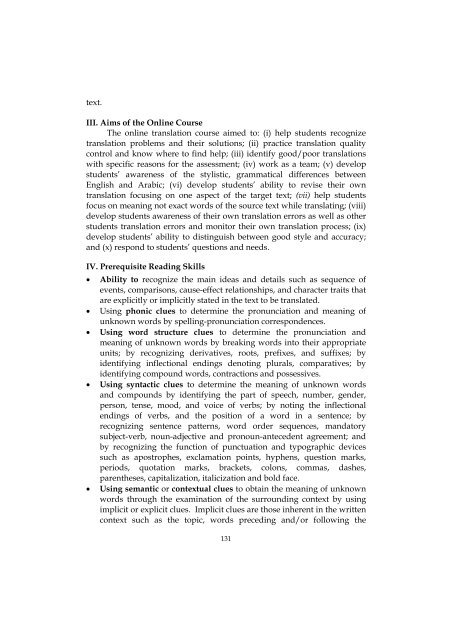translation studies. retrospective and prospective views
translation studies. retrospective and prospective views
translation studies. retrospective and prospective views
You also want an ePaper? Increase the reach of your titles
YUMPU automatically turns print PDFs into web optimized ePapers that Google loves.
text.<br />
III. Aims of the Online Course<br />
The online <strong>translation</strong> course aimed to: (i) help students recognize<br />
<strong>translation</strong> problems <strong>and</strong> their solutions; (ii) practice <strong>translation</strong> quality<br />
control <strong>and</strong> know where to find help; (iii) identify good/poor <strong>translation</strong>s<br />
with specific reasons for the assessment; (iv) work as a team; (v) develop<br />
students’ awareness of the stylistic, grammatical differences between<br />
English <strong>and</strong> Arabic; (vi) develop students’ ability to revise their own<br />
<strong>translation</strong> focusing on one aspect of the target text; (vii) help students<br />
focus on meaning not exact words of the source text while translating; (viii)<br />
develop students awareness of their own <strong>translation</strong> errors as well as other<br />
students <strong>translation</strong> errors <strong>and</strong> monitor their own <strong>translation</strong> process; (ix)<br />
develop students’ ability to distinguish between good style <strong>and</strong> accuracy;<br />
<strong>and</strong> (x) respond to students’ questions <strong>and</strong> needs.<br />
IV. Prerequisite Reading Skills<br />
• Ability to recognize the main ideas <strong>and</strong> details such as sequence of<br />
events, comparisons, cause-effect relationships, <strong>and</strong> character traits that<br />
are explicitly or implicitly stated in the text to be translated.<br />
• Using phonic clues to determine the pronunciation <strong>and</strong> meaning of<br />
unknown words by spelling-pronunciation correspondences.<br />
• Using word structure clues to determine the pronunciation <strong>and</strong><br />
meaning of unknown words by breaking words into their appropriate<br />
units; by recognizing derivatives, roots, prefixes, <strong>and</strong> suffixes; by<br />
identifying inflectional endings denoting plurals, comparatives; by<br />
identifying compound words, contractions <strong>and</strong> possessives.<br />
• Using syntactic clues to determine the meaning of unknown words<br />
<strong>and</strong> compounds by identifying the part of speech, number, gender,<br />
person, tense, mood, <strong>and</strong> voice of verbs; by noting the inflectional<br />
endings of verbs, <strong>and</strong> the position of a word in a sentence; by<br />
recognizing sentence patterns, word order sequences, m<strong>and</strong>atory<br />
subject-verb, noun-adjective <strong>and</strong> pronoun-antecedent agreement; <strong>and</strong><br />
by recognizing the function of punctuation <strong>and</strong> typographic devices<br />
such as apostrophes, exclamation points, hyphens, question marks,<br />
periods, quotation marks, brackets, colons, commas, dashes,<br />
•<br />
parentheses, capitalization, italicization <strong>and</strong> bold face.<br />
Using semantic or contextual clues to obtain the meaning of unknown<br />
words through the examination of the surrounding context by using<br />
implicit or explicit clues. Implicit clues are those inherent in the written<br />
context such as the topic, words preceding <strong>and</strong>/or following the<br />
131












